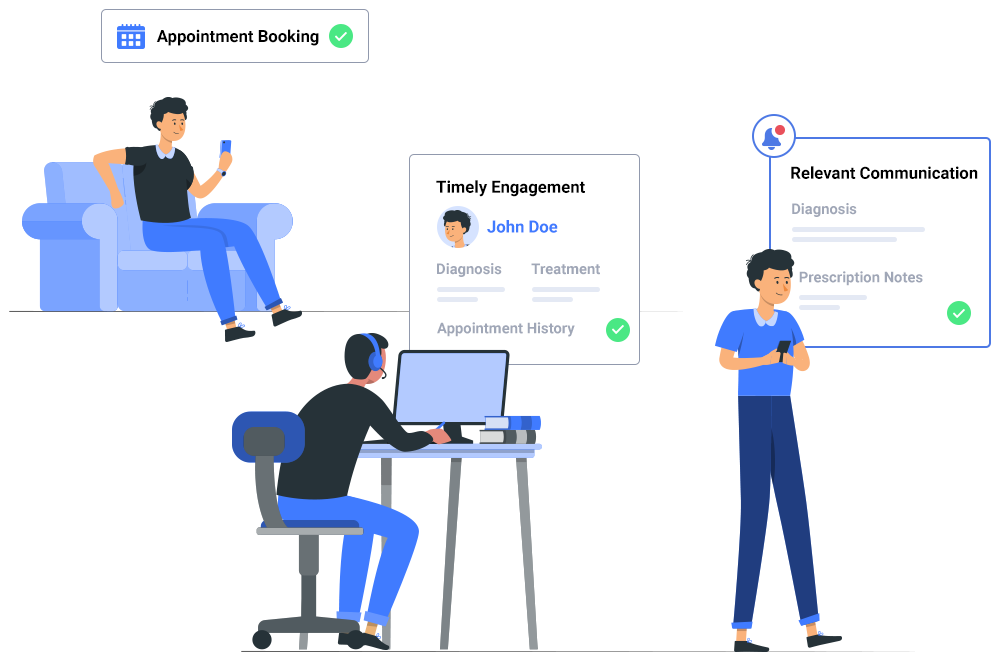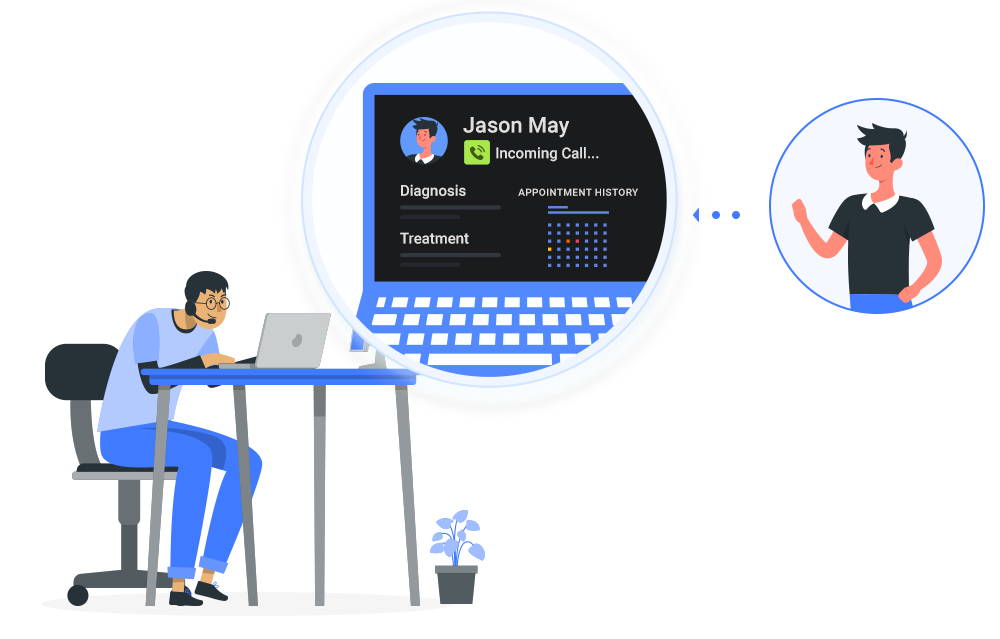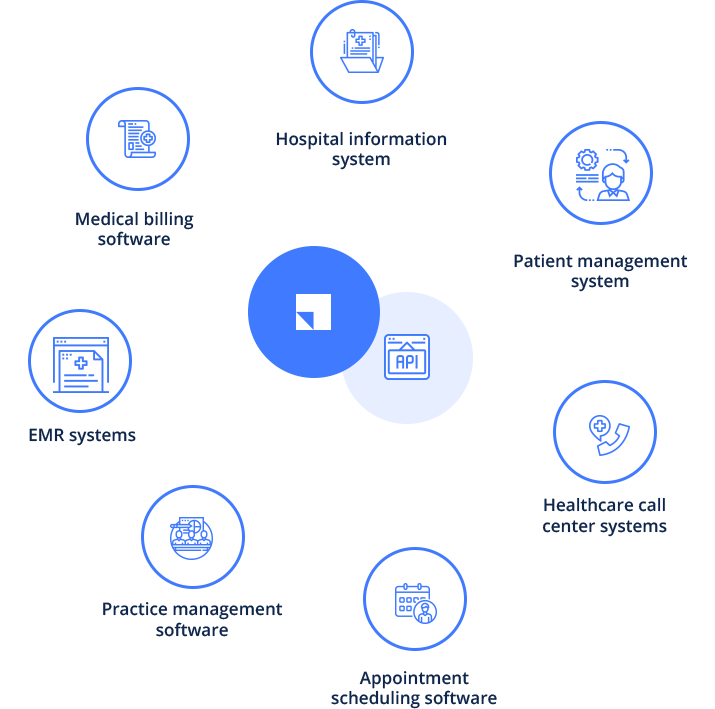Companies often focus on patient acquisition over retention. Although patient acquisition is a sure-shot way of increasing revenues, it cannot come at the cost of patient retention. According to Forbes, patient retention is on average, five times less expensive than new patient acquisition. It also enhances the clinic’s overall credibility, as repeat customers are far more likely to aid in word-of-mouth marketing.
Patient retention research shows that the average national patient growth rate is only 45% while the patient churn rate is a whopping 48%. That means healthcare providers aren’t able to build a long term relationships with their patients. And to make matters worse, 67% of patients are likely to sever ties with a brand due to bad experiences.
It’s a frustrating situation, but don’t worry. In this blog post, we’re going to talk about some effective patient retention strategies that you can implement to improve your relationship with patients and boost patient satisfaction. .
So, let’s dive in!
Why is it Important to Focus on Patient Retention?
Building trust with patients is a critical component of long-term engagement. When healthcare providers establish trust with their patients, it creates a bond that can endure various changes, such as shifts in insurance coverage or changes in healthcare providers. This bond of trust can ensures that patients continue to seek high-quality care and remain loyal to your healthcare institution.
Additionally, employing patient retention strategies can increase patient referrals. Satisfied patients are more likely to recommend your practice to their friends and family, which can lead to an influx of new patients.
Furthermore, retaining patients can also help you save on marketing costs as you will not have to spend money on acquiring new patients. It costs 90% less to retain a patient than to entice a new one!
Finally, retaining patients can lead to increased revenue for your practice. When patients return to your facility for follow-up appointments, or long-term treatments, it results in more billable services and ultimately, more revenue.
Now let’s look into a few strategies you can implement to build long-term relationships with your patients.
11 Strategies to Improve Patient Retention
1. Develop an effective communication and outreach program
One of the key factors in retaining patients is having an effective communication and outreach program. In today’s fast-paced world, patients have a lot of choices when it comes to healthcare providers. They expect timely, personalized communication and easy access to their health information.
A communication and outreach program can help you stay connected with your patients and stand apart from your competitors. According to a study, patient engagement can save costs and improve healthcare outcomes by 69%.
Following are a few activities to include in your communication program:
- Regular appointment reminders
- Follow-up calls or messages
- Patient satisfaction surveys

Moreover, patients’ overall experiences can be improved via a patient portal that allows access to health information, appointment booking, and communication with the medical staff. By making it simple for them to get the information they need and communicate with your office, there is a chance that patients will schedule more visits.
2. Make yourself accessible through phone calls
Now, let’s not forget about the good old-fashioned phone call. Sure, patient portals and online chat options are great for tech-savvy patients who prefer that kind of communication, but it doesn’t work for everyone. Sometimes you just need to talk to a real person to get the answers you need.
According to a research, 88% of patients like the concept of the call, and the ones receiving these calls find them beneficial. That’s why it’s essential also to have a dedicated phone line for patients to call and speak with a member of your team. It’s vital to have a team member who is available and willing to take calls during business hours and implement an IVR for after-hours.
[Also Read: Guide to Improve Customer Service for Healthcare Businesses for a couple of tips and strategies that’ll transform your customer service.]

Being available to your patients over the phone shows that you care about their needs and are willing to go the extra mile to provide them with the best care possible. And trust me, patients will definitely appreciate your dedication.
3. Become a part of the patient journey
So far, we’ve discussed the importance of being available to patients through different modes. Another thing that’s crucial to patient retention is providing assistance in every stage of the patient’s journey. Healthcare institutions need to understand their needs and concerns and address them proactively to become their partner in health, not just their provider.
You can start by keeping detailed patient records and tracking their progress. Integrating your EMR to your healthcare CRM will help you capture and manage patient records efficiently. It’ll also help you identify any potential issues and address them before they become more significant problems. Another way is by providing patients with educational resources and support groups which help patients understand their condition and feel more in control of their health.
Also, check in with patients and connect with them at each stage of the patient journey. Here are some examples of messages to share with patients before and after appointments:
Before the appointment:
- Appointment reminders: Reminders to patients about upcoming appointments, including the date, time, and location of the appointment.
- Pre-appointment instructions: Instructions on what patients need to do before their appointment, such as fasting, bringing a list of medications, or completing any necessary paperwork.
- Wayfinding information: Maps or directions to help patients find their way to the hospital or to the specific clinic or department where their appointment is scheduled.
- Patient education materials: Information about their condition, treatment options, and what to expect during the appointment to help them prepare and feel more confident.
After the appointment:
- Post-appointment instructions: Instructions on what they should do after the appointment, such as taking medications, scheduling follow-up appointments, or monitoring symptoms.
- Follow-up reminders: Reminders to patients about upcoming follow-up appointments or tests.
- Patient satisfaction surveys: Surveys to patients to collect feedback on their experience and identify areas for improvement.
- Educational material: Resources or guides about their condition, treatment, and self-care to help them manage their health outside of the hospital.
Always share the above-mentioned communication on the preferred mode by patients. It could be a text message, WhatsApp message, a call or even an email. Furthermore, a HIPAA-compliant Healthcare CRM enables you to integrate with the channels and automate the messages.
4. Reduce wait time and improve waiting hall experience
Anyone who’s ever been to a doctor’s consultation knows that waiting can be a real drag. And let’s be honest, nobody likes sitting around for hours, especially when they’re not feeling well. So, it’s no surprise that long wait times and a bad waiting room experience can significantly impact patient satisfaction and retention. Research shows that 1 in 5 patients switch healthcare providers because of longer wait times.
Digital intake processes and online patient portals are one of the best ways to reduce wait time. Platforms like LeadSquared provide self-serve patient portals to simplify the document collection process. Some providers also use virtual waiting rooms where patients can book appointments and complete the onboarding process from the comfort of their homes, rather than waiting at the clinic.
Once you have reduced the waiting time, the next step is to improve the waiting room experience.
Below are a few ways you can do this:
- Make the space more comfortable and welcoming
You can update the furniture or add plants or artwork. Even creating a separate play area for children can relieve the parents from a lot of trouble.
- Keep your patients engaged
Provide entertainment options like magazines, newspapers, or TVs to keep the patients engaged.
- Use this opportunity to educate patients:
Waiting halls are also a great place to educate your patients, as you can get their undivided attention. You can educate them about care management, protentional side effects and symptoms they should look for, and more. A digital signage can help you share this information and improve the waiting room experience.
Overall, providing a comfortable and welcoming environment will make patients feel more relaxed and less stressed, creating a positive experience which ensures recurrent visits and higher retention.
5. Create personalized care plans
Personalized care plans are tailored to each patient’s needs and take their medical history, lifestyle, and preferences into account. By creating a unique care plan for each patient, you’re showing that you understand their individual needs.
But to build a personalized plan, it is essential to keep detailed patient records and track their progress over time. You can use a healthcare CRM to help you keep track of patient’s medical records, activities, and history to personalize care plans.
And you can always ask them about their concerns, preferences, and goals and incorporate them into the care plan.
Even though implementing personalized care plans can be a little more time-consuming and resource-intensive than a one-size-fits-all approach, it’s worth it in the long run.
6. Build an integrated system across departments
By building an integrated system using technology, healthcare providers can streamline processes, improve communication and coordination between departments, and ultimately provide a better patient experience.
The stepping stone is to have a centralized electronic health record (EHR) system that all departments can access. This allows them to easily share patient information and eliminates the need for paper records. You can also use technology to automate administrative tasks, such as appointment scheduling, billing, and follow-up calls. It saves time, reduces errors, and improves the overall experience.
[Also Read: 7 Healthcare Workflow Automation to Improve Patient Care to learn about the processes you can automate to transform patient experience]
You can also use technology to improve communication and coordination between different departments. For example, a messaging platform can facilitate communication between doctors, nurses, and other staff members.
7. Encourage patient referrals
Research shows, 60% people are more likely to trust and follow the recommendations of friends and family. Encouraging patients to refer their friends and family can be a powerful way to grow your practice and improve retention ratios.
Additionally, when someone refers a friend or family member to your practice, it’s a sign that they’re happy with the care they’ve received and want to share that experience with others. And when patients feel good about their experience, they’re more likely to stick around.
You can use technology to make it easy for patients to refer their friends and family. Generate online forms that patients can fill out and share with their network and then distribute these forms through email or SMS post consultations. To encourage your patients, you can also incentivize referrals by offering rewards or discounts to patients who refer others to your practice.
Don’t miss out on the opportunity to ask your patients for reviews, testimonials, and feedback which can be used as referral tools.
8. Build subscription plans
It always feels nice when you get a little extra for what you paid.
Your patients can experience this “nice” feeling through subscription plans. You can create yearly or bi-yearly subscription plans that reward patients for committing to a specific care period with your practice.
The idea behind these plans is to make patients feel valued and appreciated. Patients who feel like they’re getting something special for committing to a year of care with your practice are more likely to return. These plans also encourage patients to schedule appointments in advance, which can help you better plan your schedule and keep your practice running smoothly.
To create a yearly subscription plan, healthcare providers can use various tools, such as patient management software, to track patient visits and provide rewards accordingly.
9. Create a seamless billing process
Nobody likes dealing with complicated billing processes, and it’s no different for patients. In fact, it can be a major pain point for patients and even lead to them leaving your practice. That’s why making billing easy is crucial to improving patient retention.
Here are a few ways you can make billing and onboarding easy:
- Offer online billing and payment options. This allows patients to view and pay their bills from the comfort of their own homes.
- Make it easy for patients to fill out forms and complete the discharge formalities. You can do this by providing clear instructions and allowing your patients to fill these forms online.
- Provide clear, easy-to-understand explanations of costs and insurance coverage. This can help prevent any confusion or surprises when it comes to billing.
- Provide a dedicated customer service representative to handle billing or onboarding-related queries. It ensures that patients have a positive experience and builds trust between patients and healthcare providers.
10. Provide simple hospital navigation
Navigating a healthcare facility can be daunting for patients, especially first-time visitors or those with mobility issues. Feeling lost adds no comfort when you’re already dealing with a health concern. That’s why a proper navigation system is crucial to improve patient retention.
Here are a few ways you can improve your healthcare facility’s navigation systems:
- Clearly mark and label all areas of the facility, including exam rooms, waiting areas, and restrooms.
- Provide easy-to-read maps and directories in strategic locations, such as the entrance and waiting areas.
- Utilize technology, such as interactive touchscreen directories or mobile apps, to help patients navigate the facility.
- Provide assistance to patients who may have difficulties navigating the facility, such as wheelchairs or escorts.
A proper navigation system can help patients feel less stressed and more at ease which improves their overall experience at your institution.
11. Build a welcoming and compassionate team.
Your staff is the face of your healthcare facility and the first point of contact for patients. It’s important that they’re well-trained and can provide a friendly, welcoming environment for patients. This not only helps create a positive first impression, but it can also play a big role in increasing patient retention. .
Here are a few ways to train your staff to be more patient-focused:
- Encourage them to take time with each patient and not rush them through appointments.
- Train them on the importance of active listening and empathy.
- Make sure they understand the importance of patient privacy and confidentiality.
- Provide regular customer service training to help them handle difficult situations and complaints professionally.
By training your staff to be friendly and patient-focused, you can assure your patients that they matter. Prioritising their comfort and well-being can go a long way in building trust and loyalty with your patients.
Conclusion
So, there you have it folks, the best strategies that can help you build long-term relationships with your patients. From effective communication and outreach programs to personalized care plans and reducing wait times, there are plenty of ways to keep your patients happy and coming back.
But remember, patient retention isn’t just about keeping the ones you have, it’s also about attracting new patients. Encourage referrals, create loyalty programs, and make billing and onboarding easy.

While it can be very overwhelming to manage all the activities manually, a healthcare CRM can help you automate most of the processes. To know more, you should get in touch with our team today.







